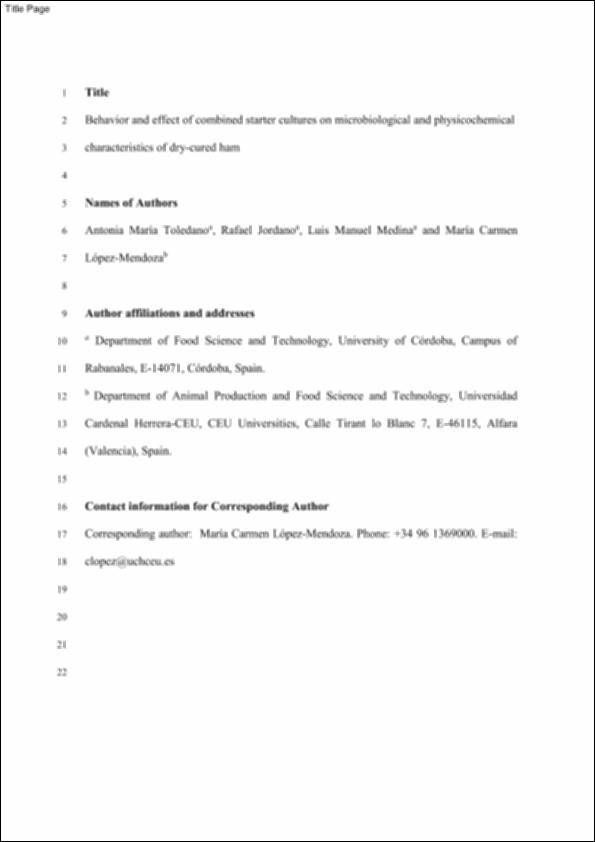Por favor, use este identificador para citar o enlazar este ítem:
http://hdl.handle.net/10637/16282Behavior and effect of combined starter cultures on microbiological and physicochemical characteristics of dry-cured ham

Ver/Abrir:
Behavior_Toledano_JFST_2019_preprint.pdf
1,11 MB
Adobe PDF
Ver/Abrir:
Behavior_Toledano_JFST_2019.pdf
Acceso restringido
499,92 kB
Adobe PDF
Request a copy
| Título : | Behavior and effect of combined starter cultures on microbiological and physicochemical characteristics of dry-cured ham |
| Autor : | Toledano, Antonia María Jordano, Rafael Medina, Luis Manuel López Mendoza, María Carmen |
| Materias: | Producto cárnico; Meat product; Ácido láctico; Lactic acid; Penicillium; Debaryomyces |
| Editorial : | Springer Nature |
| Citación : | Toledano, A.M., Jordano, R., Medina, L.M., & López-Mendoza, M.C. (2019). Behavior and effect of combined starter cultures on microbiological and physicochemical characteristics of dry-cured ham. Journal of Food Science and Technology, 56(1), 122–131. https://doi.org/10.1007/s13197-018-3465-7 |
| Resumen : | The behaviour of two combined starter cultures and their influence on the microbiological and physicochemical characteristics of dry-cured ham have been evaluated. Three lots of dry-cured hams were tested during processing (0, 9, 48, 74, 112, 142, 166 and 211 days). Lot 1 had no added starter culture. Lot 2 contained a starter culture of Penicillium chrysogenum, Penicillium digitatum, Penicillium nalgiovense, Debaryomyces hansenii, Lactobacillus plantarum, Lactobacillus acidophilus, Pediococcus pentosaceus and Micrococcus varians was and lot 3 had L. plantarum, L. acidophilus, P. pentosaceus and M. varians. The use of a selected starter culture based on a combination of lactic acid bacteria (LAB) and fungal strains with a demonstrated proteolytic activity such as P. chrysogenum and D. hansenii (lot 2) did not affect the main characteristics of dry-cured ham processing, even enhancing some desirable aspects, like its non-protein nitrogen contents. LAB strains were not significantly affected by combining them with fungal starter, and better counts were found with respect to control. A higher thiobarbituric acid reactive substances content was described in lot inoculated only with LAB (lot 3). Potentially pathogenic microorganisms were not detected in any of the lots studied. The starter culture used in lot 2 showed a potential interest for use in dry-cured ham production. |
| Descripción : | Este artículo es la versión preprint, siguiendo la política de acceso de la editorial Springer Nature. Este es el pre-print del siguiente artículo: Toledano, A.M., Jordano, R., Medina, L.M., & López-Mendoza, M.C. (2019). Behavior and effect of combined starter cultures on microbiological and physicochemical characteristics of dry-cured ham. Journal of Food Science and Technology, 56(1), 122–131, que se ha publicado de forma definitiva en https://doi.org/10.1007/s13197-018-3465-7 This is a pre-print of an article published in Toledano, A.M., Jordano, R., Medina, L.M., & López-Mendoza, M.C. (2019). Behavior and effect of combined starter cultures on microbiological and physicochemical characteristics of dry-cured ham. Journal of Food Science and Technology, 56(1), 122–131. The final authenticated version is available online at: https://doi.org/10.1007/s13197-018-3465-7 |
| URI : | http://hdl.handle.net/10637/16282 |
| Derechos: | http://creativecommons.org/licenses/by-nc-nd/4.0/deed.es |
| ISSN : | 0022-1155 0975-8402 (Electrónico) |
| Fecha de publicación : | ene-2019 |
| Centro : | Universidad Cardenal Herrera-CEU |
| Aparece en las colecciones: | Dpto. Producción y Sanidad Animal, Salud Pública Veterinaria y Ciencia y Tecnología de los Alimentos |
Los ítems de DSpace están protegidos por copyright, con todos los derechos reservados, a menos que se indique lo contrario.

